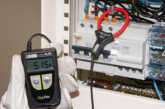
After putting the unit through its paces, Gary Fisher of Lougar Electrical gives us the full lowdown on the Di-Log DL9118 MFT.
Before 2005 when Part P officially came into force, most electricians didn’t own a tester (or insurance for that matter), choosing to depend either on luck (that what they were doing would all be ok), or employing another contractor to test and certificate their work.
Testing and certifying
In more recent times this situation has obviously changed, with electricians now testing and certifying their own work. To be able to do this properly, you must have a set of good quality testing instruments; if you don’t then you’re potentially putting yourself and those around you in danger, not to mention the safety of the electrical system you’re working on.
There really are no excuses, as good quality testers are much more affordable these days and the recently launched Di-Log DL9118 17th Edition Multifunction Tester (MFT) is a good example of this.
Firstly, it should be pointed out that you get some really nice features with this tester. It’s fully compliant with the 17th Edition regulations and I’ve no doubt it will be updated once the 18th Edition arrives. There’s also the capability to perform 1,000V insulation tests and it comes with a remote test probe and non RCD trip when carrying out low current loop testing (a feature that they call ‘RCD-LOC XLT’). An auto start for loop and continuity tests is another useful function, and shows there is plenty going on with this tester.
The more general elements of the unit include a hard black plastic sturdy box with the tester sitting very neatly inside and a tray unit on top to hold all the accompanying test leads.
The tray is always useful as you can put in a couple of screwdrivers, some connector strip and perhaps a socket interface unit, as well as other bits that help in carrying out your tests and getting the result quicker.
The colour LCD display screen is large and clear, offering plenty of detail of what is happening during each test. Located to the right of the screen is the control dial and to the left is the test button and the four functional keys (F1 – F4).
The test leads fit into the top part of the instrument and there is unique colour coding for each lead and the additional remote test probe.

Lighter weight
So what about the control rotation switch (the switch I turn to suit each test I carry out)? Compared to my usual tester I found that this switch possibly turns too easily and isn’t necessarily as sturdy as others I’ve used. In fact, the whole instrument is very light in weight, which could potentially give the (false) impression that it’s not a quality unit.
On the other hand, when you’re testing and have a unit hanging around your neck for a long period of time, then the lighter weight is very welcome, so I have no problems with it.
Putting it into practice
One of the key elements of reviews like this is the feedback from using it in my every day work. I’ll admit that it did take a little bit of getting used to, but once I had the hang of the product I found that it performed excellently across a variety of tasks.
The test results are clear to see on what has to be the biggest screen I’ve seen on a tester to date and the quicker that I picked up the functionality of the tool, the faster I was able to rattle through the test procedures.
PE readers know that, starting with the Ze test and right on through to the RCD tests, a quick and straightforward method of completing these tests is so advantageous. Fortunately the DL9118 doesn’t suffer through being too complex and I found it very easy to use and handle. It’s capable of undertaking all of the tests you require and it’s just a matter of getting used to the test function switches and selecting the appropriate function button – easy as 1-2-3!
I like this tester more than most I’ve come across during my time and if I was to compare it to other units at a similar pricing point then this is hard to beat! It’s a great all-round instrument that you’ll get plenty of years of comfortable testing from.








